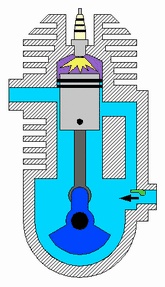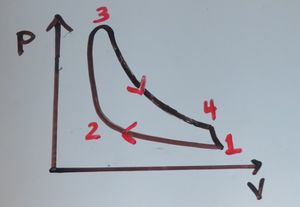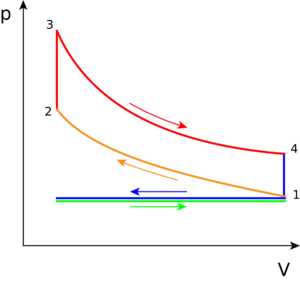
Figure 1. 2-stroke internal combustion engine[1]
As the name implies, the two stroke engine only requires two piston movements (one cycle) in order to generate power.[2] The engine is able do produce power after one cycle because the exhaust and intake of the gas occurs simultaneously,[3] as seen in Figure 1. There is a valve for the intake stroke that opens and closes due to changing pressures. In addition, due to its frequent contact with moving components, the fuel is mixed with oil to add lubrication, allowing smoother strokes.
Overall, a two-stroke engine contains two processes:
- Compression stroke: The inlet port opens, the air-fuel mixture enters the chamber and the piston moves upwards compressing this mixture. A spark plug ignites the compressed fuel and begins the power stroke.
- Power stroke: The heated gas exerts high pressure on the piston, the piston moves downward (expansion), waste heat is exhausted.
The thermal efficiency of these gasoline engines will vary depending on the model and design of the vehicle. However in general, gasoline engines convert 20% of the fuel (chemical) energy to mechanical energy—in which only 15% will be used to move the wheels (the rest is lost to friction and other mechanical elements).[4]
Compared to four stroke engines, two strokes are lighter, more efficient, have the ability to use lower-grade fuel, and more cost-efficient.[2] Therefore, the lighter engines results in a higher power-to-weight ratio (more power for less weight). However, they lack the maneuverability possible in four stroke engines and require more lubrication. This makes two stroke engines ideal for ships (need to carry a lot of cargo)[2], motorcycles, and lawn mowers—whereas a four stroke would be ideal for automobiles like cars and trucks.
The Otto Cycle

Figure 2. Real otto cycle for a two stroke engine.[5]

Figure 3. The ideal otto cycle for a gasoline engine.[6]
The pressure volume diagram (PV diagram) that models the changes the fuel-air mixture undergoes in pressure and volume in any gasoline engine is called the Otto cycle. The changes in these will create heat, and use this heat to move the vehicle or machine (hence why it's a type of heat engine). The Otto cycle can be seen in Figure 2 (real Otto Cycle) and Figure 3 (ideal Otto Cycle). The component in any engine that uses this cycle will have a piston to change the volume and pressure of the fuel-air mixture (as seen in Figure 1). The piston gains motion from combusting the fuel (where this happens is explained below), and an electric boost at the start up of the engine.
The following describes what occurs during each step on the PV diagram, in which the combustion of the working fluid—gasoline and air (oxygen), and sometimes electricity, changes the motion in the piston:
Ideal cycle-green line: Referred to as the intake phase, a two-stroke engine does not go through this phase. This is because four stroke engines begins with the piston drawn up, so it must be drawn down to intake the fuel-air mixture. However, a two-stroke engine can proceed with intaking the fuel-air mixture right away as seen in Process 1 to 2.
Process 1 to 2: During this phase, the inlet port opens, and the piston will be drawn up, so it can compress the fuel-air mixture that entered the chamber. The compression causes the mixture to increase slightly in pressure and temperature—however, no heat is exchanged. In terms of thermodynamics, this is referred to as an adiabatic process. When the cycle reaches point 2, it is when the fuel is met by the spark plug to be ignited.
Process 2 to 3: This is where combustion occurs due to the ignition of fuel by the spark plug. The combustion of the gas is complete at point 3, which results in a highly pressurized chamber that has lots of heat (thermal energy). In terms of thermodynamics, this is referred to as an isochoric process.
Process 3 to 4: The thermal energy in the chamber as a result of combustion is used to do work on the piston—which pushes the piston down—increasing the volume of the chamber. This is also known as the power stoke because it is when the thermal energy is turned into motion to power the machine or vehicle.
Purple line (Process 4 to 1): From process 4 to 1 all the waste heat is expelled from the engine chamber. As the heat leaves the gas, the molecules lose kinetic energy causing the decrease in pressure.[7] However, there is no exhaust phase in a two stroke engine, so the cycle begins (1 to 2) again by allowing a new mixture of fuel and air to be compressed.
For Further Reading
- Internal combustion engine
- Otto cycle
- Four stroke engine
- Thermal efficiency
- Or explore a random page
References
- ↑ "File:Two-Stroke Engine.gif - Wikimedia Commons", Commons.wikimedia.org, 2018. [Online]. Available: https://commons.wikimedia.org/wiki/File:Two-Stroke_Engine.gif.[Accessed: 17- May- 2018].
- ↑ 2.0 2.1 2.2 E. Alturki, "Four-Stroke and Two-Stroke Marine Engines Comparison and Application", International Journal of Engineering Research and Applications, vol. 07, no. 04, pp. 49-56, 2017.
- ↑ C. Wu, Thermodynamics and heat powered cycles. New York: Nova Science Publishers, 2007
- ↑ R. Wolfson, Energy, environment, and climate. New York: W.W. Norton & Company, 2012, p. 106.
- ↑ http://www.citethisforme.com
- ↑ Wikimedia Commons [Online], Available: https://en.wikipedia.org/wiki/Otto_cycle#/media/File:P-V_Otto_cycle.svg
- ↑ I. Dinçer and C. Zamfirescu, Advanced power generation systems. London, UK: Academic Press is an imprint of Elsevier, 2014, p. 266.
Source: https://energyeducation.ca/encyclopedia/Two_stroke_engine
Posted by: laellaelworliee0268163.blogspot.com